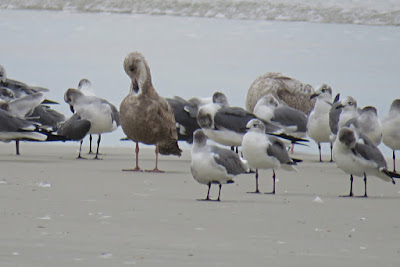We walked over the dunes on a boardwalk, then along the beach for gull lessons. Hundred of birds followed a shrimp boat farther out to sea. David got really excited when he sighted a Jaeger in the group. He describes this bird as a "cross between a gull and a peregrine falcon." It chases the gulls around until they barf up the fish they have eaten, and then he eats it. Yuck! You can recognize them even in the distance because they are larger, darker and faster than any other bird there. David sounded almost like a sports announcer at the race track as he described the attack.
The Bald Eagles were getting it on with courtship flights and copulation on a power pole. Can you imagine having sex at the top of a pole?
There must have been 10 or 12 Ospreys who did not migrate all the way to South America patrolling the shore. I love to watch them dive in for a fish and then shake all the water off when they come back up.
Along with the Laughing, Ring-billed and Herring gulls, we spotted some Lesser Black-backs and several kinds of terns, so we had good opportunities to compare them.
At first, all the Ruddy Turnstones stood on the rocks of the jetty, almost invisible to the eye. After a while though, they came over looking for hand outs. One guy turned over a dried up fish head, while a second little bird with a broken leg came right up to us. Turnstones breed in the tundra of the Arctic Circle, so we only see them in their winter plumage.
A Willet (left)and Greater Yellow-legs (right) faced off in the surf, giving us the opportunity to compare size, bill shape and coloration of these two similar birds.
At the parking lot, a little Carolina Wren told us what's what in no uncertain terms. I don't thinks our Kentucky birds are this orangey in the breast.









No comments:
Post a Comment